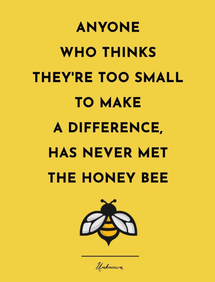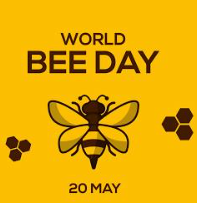 IN THE HIVE: - Watch for bearding outside the hive as it gets hotter this month. - Varroa mite population can explode if left untreated. - Swarm season will wind down mid July. - Remove entrance reducer in hotter months, like July to aid the bees in cooling down the hive. INSPECTIONS AND NUTRITION: - Continue once a month hive inspections. - Another note about dearth of forage, if you collected spring honey, you really need to monitor honey stores in the hive. - Provide a water source near the hive. PEST & COLONY MANAGEMENT: - Continue to monitor Varroa mite levels and use treatment methods and management as mentioned in May and June. - If you do split a hive, placing the queen in the new hive along with half of the colony, the original hive will not have a queen. For at least 42 days there won't be any new brood, affecting Varroa mite populations in the hive. This might be a method to help combat Varroa problems in your colonies. - This could be the last month to split your colonies during the season. The bees will need enough time to build up their supplies for winter. - Add a queen excluder if you haven't already, to manage honey supers. - You may need to remove supers if you are treating Varroa mites with chemicals. BLOOMING NOW: Early Clover, White Sweetclover, Yellow Sweetclover, Apple, Cherry, Plum, Pear, Blueberries, Raspberries, Blackberries, Deadnettle, Elderberry, Black Locust, Honeysuckle, Tulip Poplar, Hawthorn, Autumn Olive, Oak, Willow, Dandelion, Russian Olive, Milkweed, Purple Loosestrife, Yellow Rocket, Chicory, Hairy Vetch, Purple Vetch, Grape, Sumac, Knapweed, Catalpa Trees, Birdsfoot Trefoil.
0 Comments
 IN THE HIVE: - The hive population will be at its highest this month and the next. There wil be 40,000 - 60,000 bees or more per hive. - Larger colonies will continue to rear drones. - Varroa mites will continue to increase. INSPECTIONS & NUTRITION: - Perform hive inspections at least once a month now, checking brood pattern, colony growth, available space, presence of the queen or evidence she is laying. Check for pests and diseases. - Add supers if brood chambers are full and the hive population is still growing. - In the South, beekeepers can remove supers and harvest honey this month. PEST MANAGEMENT: - Monitor Varroa mite levels. If after sugar shake, alcohol wash or ether roll testing, you find 2-3 mites per 100 bees, use a Varroa mite treatment. - This is a good time of year to treat against Varroa mites by caging the queen or making splits to break the breeding cycle. COLONY MANAGEMENT: - Use the same swarm control methods as May. - Add a queen excluder if you haven't already. - Still time to catch a swarm, set up swarm traps and bait with lemongrass. - Foundation will be drawn out. - It might be necessary to extract spring honey depending on the size of your colony. - Extract honey immediately upon removing supers to prevent small beetle infestation. BLOOMING NOW: - Early clover, White Sweetclover, Yellow Sweetclover, Apple, Cherry, Plum, Pear, Blueberries, Raspberries, Blackberries, Deadnette, Elderberry, Black Locust, Honeysuckle, Tulip Poplar, Hawthorn, Autumn Olive, Oak, Willow, Dandelion, Russian Olive, Milkweed, Purple Lossestrife, Yellow Rocket, Chicory, Hairy Vetch, Purple Vetch, Grape, Sumac, Knapweed, Catalpa, Birdsfoot Treefoil.  Come on down Saturday, May 11, 2024 for the Mooresville Street Fair held in downtown Mooresville. Pop in and visit us at the White Lick Beekeepers booth. Get up close and personal with the bees at our Observation Hive. The fair is from 10:00AM - 3:00PM  IN THE HIVE: -Egg laying is very high now, along with brood rearing and expansion of the brood area. -The bees are actively foraging pollen and nectar. -Bees are less defensive now than in the fall, when they are trying to protect their stores. Also, during daytime inspections, there are less bees in the hive to be bothered by the beekeeper, and the ones in the hive are extremely busy and distracted. -Because of the rapidly growing population of the hive, overcrowding is highly possible, thus making May the swarm season. -The drone population is growing, look for queen cups along the edges of brood frames. If the hive is crowded, cups will have been laid in. -Keep in mind the Varroa population is also growing now. INSPECTIONS & NUTRITION: -Hive inspections should be be done about every 2 weeks. -Move the bottom hive body above the brood nest if it is empty. -Check for signs that supplemental feeding might be beneficial, especially with package bees or nucs. You can feed a 1:1 sugar syrup. -If brood chambers are full and stores are growing, provide supers. PEST MANAGEMENT: -Consider monitoring Varroa mite levels with an alcohol or sugar shake. COLONY POPULATION: -To prevent/discourage swarms, make sure your bees aren't too crowded. Make sure the queen has access to lay eggs and that the brood nest isn't honey bound. -Make room for a growing hive population if needed by moving honey combs out of the brood nest and into a super. -Look for swarm cells often. Consider splitting stronger colonies to prevent swarming. If you are equalizing by mixing weak and strong colonies, check for disease and pests in the weaker colony before you combine them. -This is a great month to expand your apiary by catching swarms (and its great fun.) -This is a great month to requeen if you can find local queens this early. MISCELLANEOUS: -Are you rearing queens? Swarm season is the best time to rear queens. -Consider adding queen excluder at this time to manage honey supers. BLOOMING NOW: -Elm, Willow and Poplar trees, Maple and Oak trees, Wild Strawberry, Dandelions, Deadnette, Yellow Rocket, Honeysuckle, Elderberry. -Many fruit trees are blooming including Cherry, Apple, Crabapple, Pears, Peaches and Plums. -Multiple Clovers, Mustard, Hawthorn, Black Locust, Blueberries, Raspberries and Blackberries. |
Join usLearn About Honeybees Shop our new club store for great WLBA merchandise!
|
|
© 2010-2023• WHITELICKBEEKEEPERS, West-Central, Indiana • Contact Us
|


